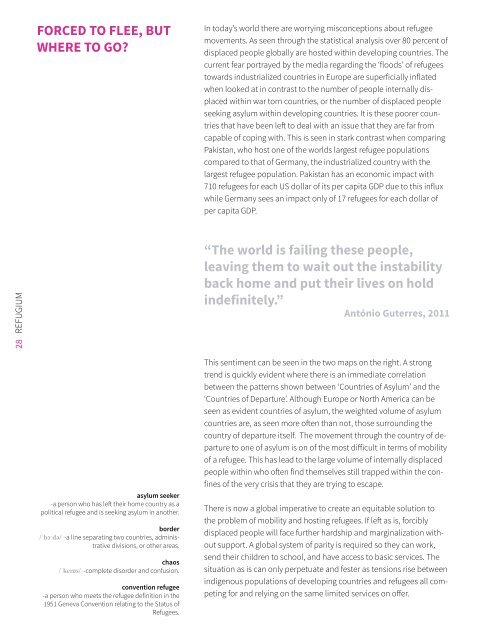You also want an ePaper? Increase the reach of your titles
YUMPU automatically turns print PDFs into web optimized ePapers that Google loves.
FORCED TO FLEE, BUT<br />
WHERE TO GO?<br />
In today’s world there are worrying misconceptions about refugee<br />
movements. As seen through the statistical analysis over 80 percent of<br />
displaced people globally are hosted within developing countries. The<br />
current fear portrayed by the media regarding the ‘floods’ of refugees<br />
towards industrialized countries in Europe are superficially inflated<br />
when looked at in contrast to the number of people internally displaced<br />
within war torn countries, or the number of displaced people<br />
seeking asylum within developing countries. It is these poorer countries<br />
that have been left to deal with an issue that they are far from<br />
capable of coping with. This is seen in stark contrast when comparing<br />
Pakistan, who host one of the worlds largest refugee populations<br />
compared to that of Germany, the industrialized country with the<br />
largest refugee population. Pakistan has an economic impact with<br />
710 refugees for each US dollar of its per capita GDP due to this influx<br />
while Germany sees an impact only of 17 refugees for each dollar of<br />
per capita GDP.<br />
28 REFUGIUM<br />
“The world is failing these people,<br />
leaving them to wait out the instability<br />
back home and put their lives on hold<br />
indefinitely.”<br />
António Guterres, 2011<br />
asylum seeker<br />
-a person who has left their home country as a<br />
political refugee and is seeking asylum in another.<br />
border<br />
/ˈbɔːdə/ -a line separating two countries, administrative<br />
divisions, or other areas.<br />
chaos<br />
/ˈkeɪɒs/ -complete disorder and confusion.<br />
convention refugee<br />
-a person who meets the refugee definition in the<br />
1951 Geneva Convention relating to the Status of<br />
Refugees.<br />
This sentiment can be seen in the two maps on the right. A strong<br />
trend is quickly evident where there is an immediate correlation<br />
between the patterns shown between ‘Countries of Asylum’ and the<br />
‘Countries of Departure’. Although Europe or North America can be<br />
seen as evident countries of asylum, the weighted volume of asylum<br />
countries are, as seen more often than not, those surrounding the<br />
country of departure itself. The movement through the country of departure<br />
to one of asylum is on of the most difficult in terms of mobility<br />
of a refugee. This has lead to the large volume of internally displaced<br />
people within who often find themselves still trapped within the confines<br />
of the very crisis that they are trying to escape.<br />
There is now a global imperative to create an equitable solution to<br />
the problem of mobility and hosting refugees. If left as is, forcibly<br />
displaced people will face further hardship and marginalization without<br />
support. A global system of parity is required so they can work,<br />
send their children to school, and have access to basic services. The<br />
situation as is can only perpetuate and fester as tensions rise between<br />
indigenous populations of developing countries and refugees all competing<br />
for and relying on the same limited services on offer.




